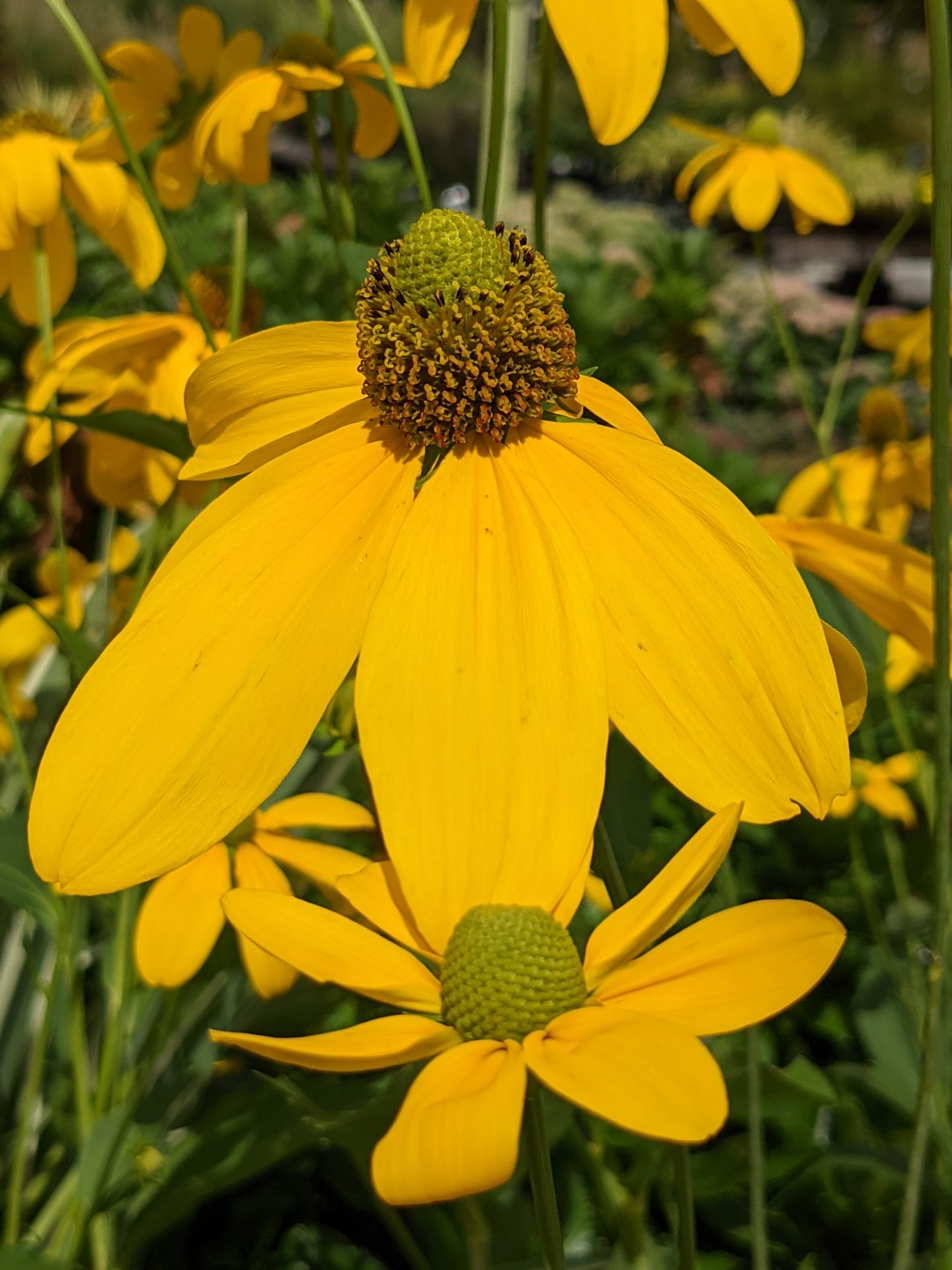
Mid-summer sees rudbeckia, one of America’s iconic flowering plants, burst into bloom. The varieties of this plant go by several names – Black Eyed Susan, Coneflower and Gloriosa Daisy to name a few, but all of them bring cheerfulness to summer gardens.
Rudbeckia fulgida is probably the most recognizable coneflower here in New England and is commonly known as Black Eyed Susan, as well as Orange Coneflower or Showy Coneflower. Native to open spaces in the eastern half of the US from New Jersey south to Florida and Texas, this perennial coneflower produces plenty of yellow flowers. R. fulgida var. sullivantii ‘Goldsturm’ is a cultivar similar to the species, growing 30” tall. For something a little shorter, R. fulgida var. sullivantii ‘Little Goldstar’ offers a mass of smaller yellow flowers on a plant that reaches 14-16” tall. And finally, R. fulgida ‘Viette’s Little Suzy’ is even more compact cultivar growing about 12-14” tall.
Rudbeckia maxima, Giant Coneflower, Giant Brown-Eyed Susan or Cabbage Leaf Coneflower, is a tall, but airy coneflower reaching about 6’ tall. It has large, glaucous leaves reminiscent of cabbage leaves, and it produces tall stems with few, but large flowers. The brown ‘cone’ is particularly pronounced and surrounded with a ring of single petals that hang down. Native to the southeast U.S. it is a great accent plant, and has a preference for moist, well-drained soil, where it will spread by rhizomes to form dense colonies. Having said that, the established plants in my yard do not get such favored conditions, but while they have not spread, they have also stood up well in this summer’s drought.


Rudbeckia nitida, Shiny or Tall Coneflower, is another coneflower of impressive size reaching about 6-7’ tall and forming a dense clump of stems. This is a great back-of-the-border plant, possessing deep green, notched leaves, which are topped with stems bearing multiple large yellow flowers, whose petals also hang down. It is native to southeastern U.S., also prefers moist conditions, but has winter hardiness suitable for New England gardens. Look for the cultivar ‘Herbstonne’ if this rudbeckia appeals.
Rudbeckia subtomentosa, Sweet Coneflower, is so named as the flowers have a light anise scent. Native to the central U.S., it grows up to 5’ tall and while it too prefers moist conditions, it is actually drought and humidity tolerant once established. Producing branching stems with many yellow flowers, it makes particularly good cut flowers. The cultivar ‘Little Henry’ is a more compact 3’ tall and has distinctive quilled outer petals, which look as if they have been rolled into tubes.
Rudbeckia triloba, Brown-Eyed Susan is a short-lived perennial which grows around 3-5’ tall and 3-4’ wide. Native to the eastern and central U.S. it is a mass of small daisies with a long blooming season, and is tolerant of a wide range of growing conditions. Despite its short-lived nature, it will readily self-seed if allowed, thus ensuring replacement plants. The cultivar ‘Prairie Glow’ offers a mass of gold, orange and even brown-splashed flowers on dark green stems.
And lastly for this selection, rudbeckia hirta, Gloriosa or Denver Daisy, can commonly be found in garden centers at this time of year, as it is an annual/biennial coneflower. Making a colorful component of fall containers, this coneflower has yellow, orange, and red-ringed petals depending on the cultivar. It is also easily grown from seed in spring, and if allowed to go to seed, will come back year after year. Mine have moved around throughout my flower borders for the past seven years since the original seeds were sown.
All coneflowers are popular with pollinators, their seed heads provide a valuable food source for songbirds and finches, and they are deer and rabbit resistant, although this dry summer led to a few of my ‘Goldsturm’ rudbeckia being ‘pruned’ by a desperate deer as they were coming up to bloom. They have since recovered and are putting on a late, if somewhat reduced show, proving that these wonderful plants can cope with several adversities and still come back smiling!
Sources:







